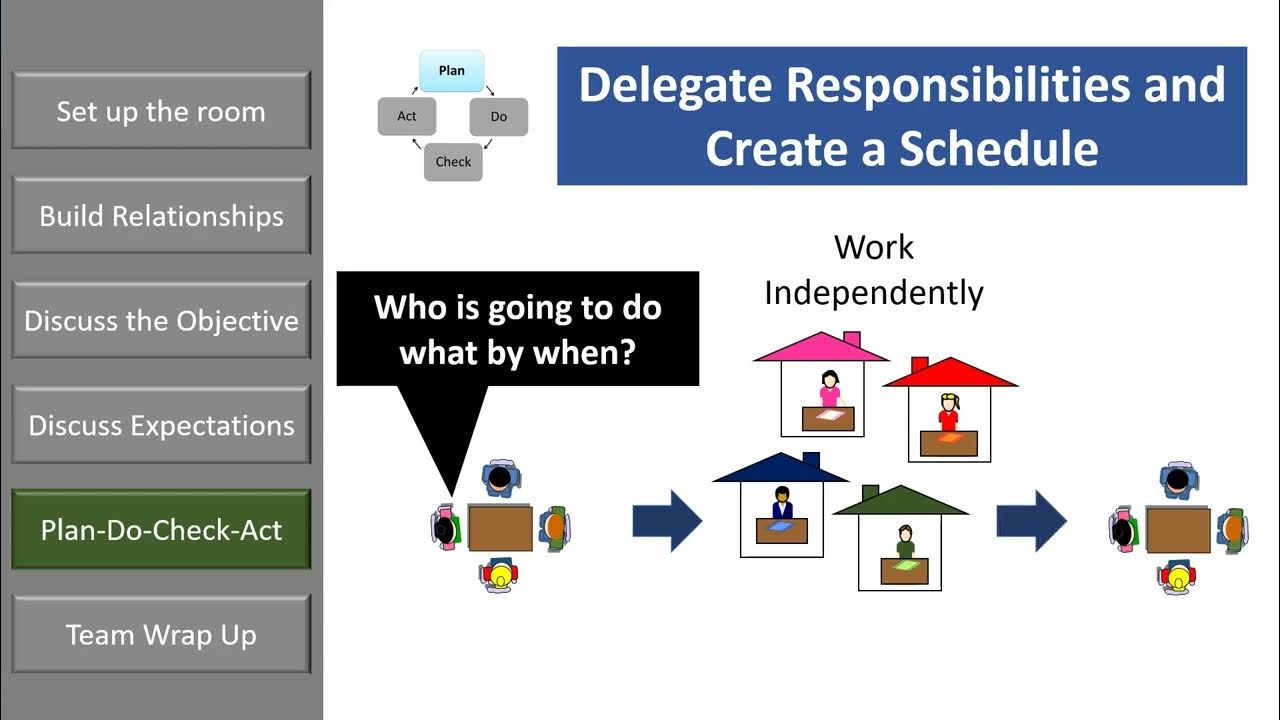Belbin's Team Roles
Summary
TLDRThis lesson introduces Belbin's Team Roles model, which helps individuals understand their preferred behavior in a team setting. Developed by Meredith Belbin in the 1970s, the model categorizes team roles into three main groups: thinking-oriented, action-oriented, and people-oriented. By understanding these roles, team members can improve their contributions, and leaders can build more balanced and effective teams. The model also offers strategies for improving existing teams by addressing imbalances and resolving conflicts. Overall, Belbin’s model is a valuable tool for enhancing team dynamics, boosting performance, and fostering better collaboration.
Takeaways
- 😀 Belbin's Team Roles model helps understand how people behave within a team, not their personality traits.
- 😀 The model categorizes roles into three broad groups: thinking-oriented, action-oriented, and people-oriented.
- 😀 Understanding team roles can help improve team performance, develop individual skills, and balance team composition.
- 😀 Thinking-oriented roles are critical for generating new ideas and evaluating them, but may lack practical application and drive.
- 😀 Action-oriented roles focus on getting things done, driving team progress, but can be inflexible or confrontational.
- 😀 People-oriented roles are essential for team cohesion and communication but can suffer from indecision or too much diplomacy.
- 😀 The nine Belbin team roles include: Plant, Monitor Evaluator, Specialist, Shaper, Implementer, Completer Finisher, Coordinator, Team Worker, and Resource Investigator.
- 😀 Plants generate innovative ideas but may struggle with deadlines and practicality, while Monitor Evaluators analyze and critique those ideas.
- 😀 Shapers drive the team forward under pressure, but they can be confrontational, while Implementers turn ideas into action with an organized approach.
- 😀 Completer Finishers focus on detail and project completion, though they may resist delegating tasks and worry about deadlines.
- 😀 A balanced team includes a mix of roles, and the model can help adjust teams to overcome imbalances or improve their effectiveness.
- 😀 When forming a new team, it’s important to balance roles across different categories and match roles to specific project needs or team functions.
Q & A
What is the main focus of Belbin's Team Roles model?
-Belbin's Team Roles model focuses on understanding people's preferred behaviors within a team, specifically how they do things (their behavior) rather than their personality traits.
Why is it important to understand Belbin's Team Roles in team management?
-Understanding Belbin's Team Roles helps improve individual performance in a team, allows leaders to create more balanced teams, and helps address imbalances in existing teams.
How did Meredith Belbin develop his team roles model?
-Meredith Belbin developed the model in the 1970s by studying managers' personality types and preferred working styles, then observing these individuals in teams to identify effective teamwork behaviors.
What are the three main categories of Belbin's team roles?
-The three main categories of Belbin's team roles are thinking-oriented roles, action-oriented roles, and people-oriented roles.
What is the role of a 'Plant' in a team?
-A 'Plant' is an innovative thinker who generates new ideas. However, they may struggle with deadlines, budgets, and practical implementation, and can be sensitive to criticism.
What are the weaknesses associated with the 'Monitor Evaluator' role?
-Monitor Evaluators are great critical thinkers, but they may lack motivation, struggle to drive others, and can be overly critical of other team members' ideas.
How does the 'Shaper' role benefit a team?
-The 'Shaper' challenges the team to improve and performs well under pressure. They push for results and drive the team forward, though they can sometimes be confrontational and argumentative.
Why are 'Completer Finishers' important in a team?
-Completer Finishers ensure that projects are thoroughly completed, paying attention to detail and ensuring deadlines are met. However, they can be perfectionistic and prefer doing tasks themselves rather than delegating.
What is the potential drawback of having too many 'Team Workers' in a team?
-Having too many Team Workers can lead to indecisiveness and a lack of action, as they may prioritize diplomacy and harmony over making decisions or taking risks.
How can leaders use the Belbin model to form a balanced team?
-Leaders can use the Belbin model to ensure a balance of roles across thinking-oriented, action-oriented, and people-oriented categories, matching roles to the needs of the team and specific projects.
Outlines

This section is available to paid users only. Please upgrade to access this part.
Upgrade NowMindmap

This section is available to paid users only. Please upgrade to access this part.
Upgrade NowKeywords

This section is available to paid users only. Please upgrade to access this part.
Upgrade NowHighlights

This section is available to paid users only. Please upgrade to access this part.
Upgrade NowTranscripts

This section is available to paid users only. Please upgrade to access this part.
Upgrade NowBrowse More Related Video

Bad Presentation Masterclass

Belbin's Team Roles For Beginners

How to Join Others in Direct Selling @Directsellingsuccessguaranty

Tuckman's 5 Stages of Team Development (Forming, Storming, Norming, Performing, Re-forming)

Os 3 elementos para gestão estratégica de pessoas

Developing Good Habits for Working in Teams (Part 2)
5.0 / 5 (0 votes)